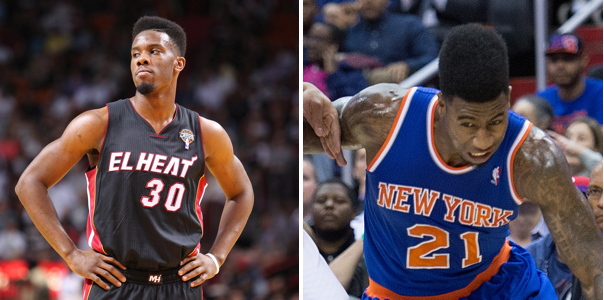Welcome to The Current’s newest column, in which we discuss the latest fashion trends in the National Basketball Association.
Ever since NBA commissioner David Stern introduced a league-wide dress code for his players, NBA athletes’ fashion has soared to new extremes. (Note that I didn’t say heights.) After a couple years of players wearing suits on the sidelines, sports fashion has evolved into hipster glasses without lenses, LeBron James Instagramming his “#leathersweatshorts” and Russell Westbrook dressing like the wallpaper at a pediatrician’s office.
As fashion in athletics becomes more ridiculous, The Current will tag along for the ride to provide the valuable insight you so desperately crave.
For starters, with the NBA playoffs rapidly approaching, and with them news conference fashion choices, let’s stay away from threads for now and start with something more simple — hair.
Athletes generally aren’t noticed for their hair unless they do something truly ridiculous. I’m talking Dennis Rodman in the mid-90s with his neon-green hair, accented by multiple nose rings. For the most part, those flashy styles of the 90s have dissipated, with players who are more concerned about their look — and their image — sticking to simple choices, such as buzz cuts.
But two NBA players have brought back the flair of the 90s.
Norris Cole of the Miami Heat and Iman Shumpert of the New York Knicks both sport legitimate hi-top fades. When I say hi-top fades, I mean the kind of hi-tops that would make Gerald from “Hey Arnold” blush. Cole has been rocking the style on-and-off since his college days, while Shumpert seemingly only entered the fold in the past year or so.
The hi-top fade was a serious hit back in the day. Made famous by the hip-hop community and loyal hi-topper Christopher “Kid” Reid, the haircut spanned music videos from the late 80s to the late 90s. As calendars flipped toward the millennium, the haircut was replaced with cornrows, buzz cuts and newer looks.
But just as the gods graced us with “Girl Meets World,” the hi-top fade is also slowly re-emerging, thanks in part to players like Cole and Shumpert.
Although those two players get some quality minutes on arguably the two most-followed teams in the NBA, they aren’t exactly major stars. However, their decision to sport a haircut often associated with 90s rap or the hip-hop community is actually quite bold in today’s NBA.
It’s no secret that after the Pacers-Pistons brawl in Auburn Hills, when players fought fans in the stands, Stern and the NBA tried hard to fix what they perceived as an image problem. We don’t have to delve into the racial undertones of the NBA, but let’s just say Stern’s decision to have players wearing suits instead of throwback jerseys was just one step to appease the league’s desired viewing audience.
Although Cole and Shumpert aren’t exactly taking a moral stand, their haircuts are attempts at individuality in a league often nervous about its public image. Shumpert has even gained a small following, mostly from New York fans, through his own hip-hop endeavors. The Knicks’ shooting guard recently created even more waves with his hair for shaving an Adidas logo into it, drawing a fine from the NBA.
Cole and Shumpert may not ever be known as men willing to take a stand against “The Man.” And they shouldn’t. But the two players and their hi-top fades shouldn’t be overlooked (literally or figuratively) either.


